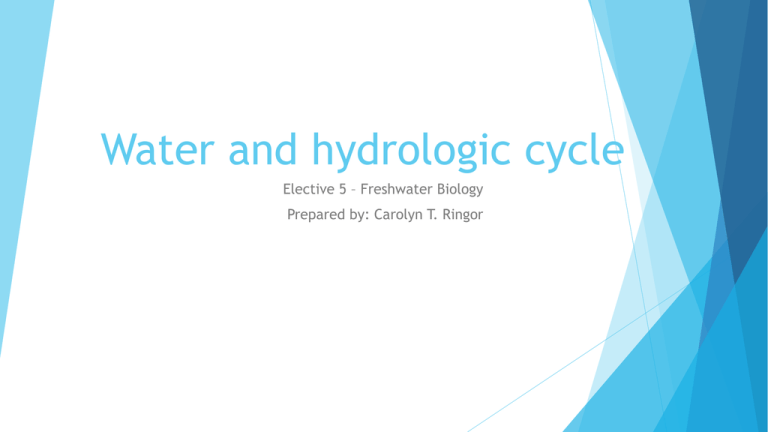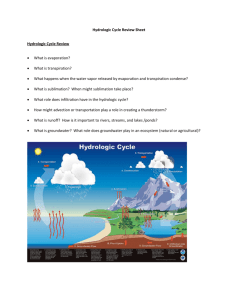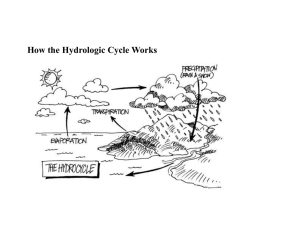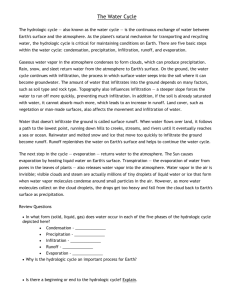Water and hydrologic cycle
advertisement

Water and hydrologic cycle Elective 5 – Freshwater Biology Prepared by: Carolyn T. Ringor Content Outline Definition of Water Importance of water in living thing Common usage of water Definition of Hydrology The Hydrologic cycle Evaporation (Evapotranspiration) Precipitation Infiltration Runoff Subsurface flow Water Water is a colorless, odorless and tasteless liquid It is made up of 1 oxygen molecule and 2 hydrogen molecules bonded by a covalent bond Importance of water in living things 60% of water is found in the human body 70% is found in the brain 90% is found in the lungs 83% is found in the blood which helps digest foods, transports waste and control body temperature Usage of water Water is very vital to life, among the usage of water in our daily lives includes: Drinking Cooking Irrigations in Agricultural lands Used to generate electricity (Hydropowers) Hydrology Hydrology is the study of movement and distribution of water through out the earth. Hydrologic cycle Water cycle or hydrologic cycle is one among the cycles which makes up the biogeochemical cycles. it is the circulation of the water in the earth’s hydrosphere It involves changes in the physical state of water between solid, liquid and gas phase. It also refers to the continuous exchange of water between the atmosphere, land, surface and subsurface waters and organisms. Insert water cycle here Component of Hydrologic cycle: Evaporation Evaporation occurs when radiant energy from the sun heats water which causes the water molecules to become active. When the water molecules becomes active some of these molecules goes up in the form of vapour The transformation of liquid water becoming gas requires energy Component of Hydrologic cycle: Evaporation About 90% of the atmospheric water comes from evaporation, while the remaining 10% is transpiration. Transpiration occurs when plant takes in water through the roots and release it through the leaves The transpiration is one of the natural processes where water is cleaned by removing contaminants and pollution from the environment Component of Hydrologic cycle: Precipitation Raising warm air carries water vapor high into the sky where it cools, forming water droplets around tiny bits of dust in the air. Some vapor freezes into tiny crystals which attracts cooled water drops. The drops freezes into ice crystals, forming larger crystals known as snowflakes. When snowflakes becomes heavy, they starts to fall. When the snowflakes meets warmer air on their way down, they melt and forms raindrops. Atmospheric temperature below 32°C Atmospheric temperature above 32°C Snowflakes partially melt in the layer of warmer air, then freezes again when it meets the cold air the ground. This kind of precipitation is called sleet. Component of Hydrologic cycle: Infiltration At some circumstances precipitation actually evaporates before it reaches the surface. Infiltration is the transition from surface water to ground water. The infiltration rate is dependent on the soil and rock permeability. I n f i l t r t i o n Surface water Soil Rock Groundwater Aquifer Component of Hydrologic cycle: Infiltration The amount of water that infiltrates the soil varies with the: Degree of land slope Soil type and rock type Amount and type of vegetation Amount of water in the soil The more openings in the surface (Cracks, pores and joints) the more infiltration occurs. Component of Hydrologic cycle: Run off Precipitation that reaches the surface of the earth but does not infiltrate the soil is called run-off. Run-off comes from melted snow and ice. Run-off includes variety of ways by which land surface and water moves down the slope to the ocean. Not all precipitated water returns to the sea as runoff. Much of it evaporates before reaching the aquifer or the sea. Component of Hydrologic cycle: Subsurface flow Surface flow incorporates movement of water within the earth, either within the recharge zone or aquifer. After infiltrating subsurface water may return to the surface or eventually seep into the ocean








